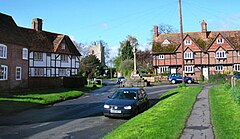East Hagbourne
| East Hagbourne | |
|---|---|
 Houses at Upper Cross |
|
| East Hagbourne shown within Oxfordshire | |
| Area | 3.90 km2 (1.51 sq mi) |
| Population | 1,882 (2011 Census) |
| • Density | 483/km2 (1,250/sq mi) |
| OS grid reference | SU527883 |
| Civil parish |
|
| District | |
| Shire county | |
| Region | |
| Country | England |
| Sovereign state | United Kingdom |
| Post town | Didcot |
| Postcode district | OX11 |
| Dialling code | 01235 |
| Police | Thames Valley |
| Fire | Oxfordshire |
| Ambulance | South Central |
| EU Parliament | South East England |
| UK Parliament | |
| Website | EastHagbourne.Net |
East Hagbourne is a village and civil parish about 1 mile (1.6 km) south of Didcot and 11 miles (18 km) south of Oxford. It was part of Berkshire until the 1974 boundary changes transferred it to Oxfordshire. The 2011 Census recorded the parish's population as 1,882.
East Hagbourne's toponym is derived from Hacca's Brook, a stream that flows through the village. East Hagbourne was sometimes called Church Hagbourne.
East and West Hagbourne have been separate villages since the time of Edward the Confessor, when Regenbald, a priest of Cirencester, held the manor of East Hagbourne. Regenbald continued to hold the manor after the Norman conquest of England in 1066 and compilation of the Domesday Book in 1086. Regenbald died in the reign of Henry I, who then granted East Hagbourne manor to the Augustinians Cirencester Abbey (founded 1117). The abbey continued to hold the manor until 1539, when it surrendered its lands to the Crown in the Dissolution of the Monasteries.
The nave of the Church of England parish church of Saint Andrew may have been built in the 12th century. The south aisle was added early in the 13th century. It is linked with the nave by a three-bays arcade. It was followed a few years later by the south chapel, which is alongside the chancel and linked to it by a two-bay arcade. The chancel arch was built in the middle of the 13th century. The north aisle, also of three bays, was added about 1340, followed by the Decorated Gothic north chapel, which is alongside the chancel and linked with it by a two-bay arcade.
...
Wikipedia

